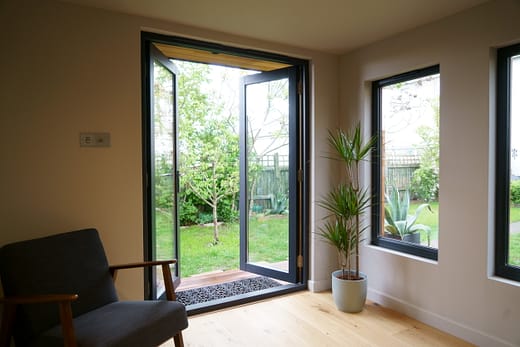We will be closed for Christmas from 3pm on Friday 19th Dec and re-opening on Monday 5th Jan. Any orders placed now will be delivered in the New Year. Merry Christmas!
We will be closed for Christmas from 3pm on Friday 19th Dec and re-opening on Monday 5th Jan. Any orders placed now will be delivered in the New Year. Merry Christmas!
We will be closed for Christmas from 3pm on Friday 19th Dec and re-opening on Monday 5th Jan. Any orders placed now will be delivered in the New Year. Merry Christmas!

Home / How to Insulate French Patio Doors
 If you’re looking for a way to extend your home out into your patio, and vice versa, then the traditional French door has a great deal to offer. They make a fantastic addition to the modern home and garden, neatly bridging the two and creating a single, cohesive space.
If you’re looking for a way to extend your home out into your patio, and vice versa, then the traditional French door has a great deal to offer. They make a fantastic addition to the modern home and garden, neatly bridging the two and creating a single, cohesive space.
French doors were first developed to allow French aristocrats to look out onto their estates, and to allow natural light to permeate the interior. Both virtues also apply to the modern French door, too.
French Doors are a traditional and relatively affordable alternative to more modern styles of patio doors, like folding and sliding doors. Flanked by a pair of sidelites, they can create just as big a visual impact, but without the price-tag.
Check out our range of internal French doors here!

One of the alleged drawbacks of a set of French doors is that they aren’t very energy-efficient. This stems from the fact that they’re made largely from glass, which conducts more heat than solid wood.
But glazing technology has advanced considerably over the past few decades. What might have been considered an energy-efficient external door in the 1990s is surely, by modern standards, antiquated. This is thanks to the steady improvement of several technologies, including double-glazed glass packed with inert gas, metal-oxide coatings which reflect energy back into the home, and ‘engineered’ cores which provide structure and resist the warping that allows draughts to creep in. As such, double-glazed French doors are typically very energy efficient.
As well as offering greater energy efficiency, double-glazed exterior French Doors tend to provide superior security and safety, since the glass will be harder to break.
Finally, double-glazed French doors tend to last longer than the alternatives. They offer superior insulation, and will help future-proof a property for longer. To get the best out of yours, however, you’ll need to perform regular maintenance. This is especially so in the case of timber doors, which should be periodically sanded and re-finished in order to protect them from warping and rot.

Energy efficiency is crucial to the modern home, and by extension the doors around it. There are several reasons for this. To start, building regulations demand that external doors can contain a certain amount of heat in your home. If your French doors open out onto a sufficiently robust conservatory, this might be less of a concern, but for most of us, it is.
Another important consequence of having an energy efficient home, however, is that it’ll save you money. The less heat escapes from your property, the less energy you’ll need to spend generating heat to replace it, and the lower your energy bills will be.
Finally, it’s worth considering the environmental cost of using all that extra energy. If your doors are leaking a lot of heat, you’ll end up using more heat trying to keep the inside of your house warm. For the most part, this energy will come from burning fossil fuels which contribute to man-made climate change.
The most popular measure of energy efficiency in your home is the U-value. This describes how effective a material is as an insulator. The lower the value, the less heat is able to pass through a given area of material in a given amount of time. It’s typically measured in watts per metre squared. A standard double-glazed window will have a U-value of just under three.
This measure of efficiency, while accurate, tends not to be terribly useful for homeowners. The figure advertised tends to only account for one part of the door (the glass) and only in a specific area (typically the dead centre). It’s therefore worth considering the colour-coded energy ratings offered by the British Fenestration Council, which vary from A++ right down to E (the lowest legally available). Not only are these ratings more understandable, they cover the performance of your entire unit – whether that’s a window, door or something else.
Wooden French doors tend to be more efficient than their uPVC equivalents because the material is much denser. Heat, therefore, has a far more difficult time passing from one side of the material to the other.
Check out our range of external French doors here!

If you’re the owner of an old set of exterior French doors which aren’t quite as energy-efficient as they ought to be, you have two options:
The former option is well worth exploring, as with just a little bit of money and effort you’ll be able to vastly improve the energy-retaining performance of the door.
There are a few different ways you can improve your French door insulation and draught-proofing:
Look at the edges of your door, and you’ll see strips of weather-stripping. This is designed to compress when the door is closed, and form a tight seal that’ll keep draughts at bay. Door seals tend to come in the form of either brushes or lengths of rubber. To replace your weather-stripping, it’s best to first remove the old strips and take them down to your local hardware shop. That will make it easy to find a like-for-like replacement.
If your draught is coming through the bottom of your door, a draught-excluder will help. These long, cushion-like devices are built to sit on the floor and form a barrier. If the draught is between the two doors, however, your options will be extremely limited – short of stuffing a layer of felt or rubber in between the doors during the winter, or hanging a plastic sheet over the entire door, there’s little you can do.
Gas leaking from between the double-glazing is another cause of energy inefficiency. This happens when the seals around your double glazing have broken down. You’ll know if this has happened to you because condensation will be visible between the panes of glass; if moisture can get in, then the gas will almost certainly already have gotten out. The inert gas between double glazing panes conducts much less heat than normal air and so if it has leaked out, your glazing will be less efficient. It’s impossible to repair this wear-and-tear, and so it so you will require either a double glazing replacement or a door replacement. As this breakdown is a sign that the door is nearing the end of its life, many people opt to replace their French doors.
Insulating your French doors will help you keep all the heat inside your home, but this can affect the condensation that forms on them. If this happens there is no need to be concerned, but you can take a look at our guide on how to prevent condensation for tips on how to tackle it.
Want to take a look at our French door products? Check these out!
Or take a look at these great informational articles:
You’ll need to trim mm off the left & right of each door
You’ll need to pack mm either side of the frame
You’ll need to trim mm off the top and bottom of each door
You’ll need to pack mm above
You’ll need to trim mm off the left & right of each door
You’ll need to pack mm either side of the frame
You’ll need to trim mm off the top and bottom of each door
You’ll need to pack mm above
You’ll need to trim mm off the left & right of each door
You’ll need to pack mm either side of the frame
You’ll need to trim mm off the top and bottom of each door
You’ll need to pack mm above